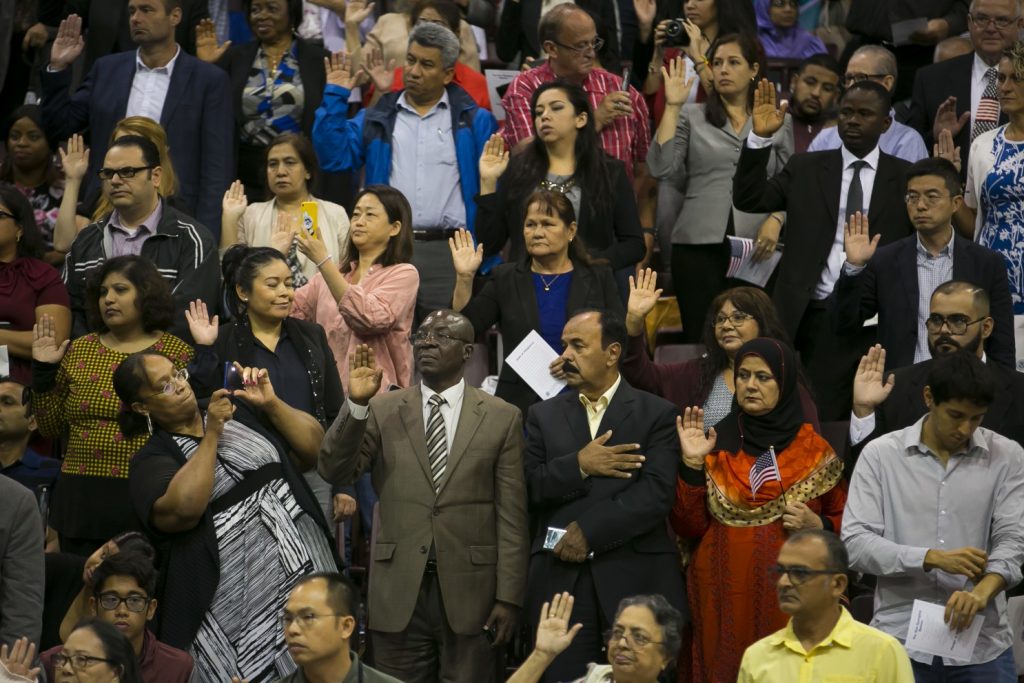(ThyBlackMan.com) Like Sherlock Holmes’ dog that didn’t bark in the night, so goes in politics: Uncharacteristic behavior can turn out to be crucially significant — uncharacteristic behavior in politics being defined as one demographic group unexpectedly trending one way when most of the electorate trends the other.
Such behavior was the subject of The New York Times’ graphic team’s report headlined “Immigrant Neighborhoods Shifted Red as the Country Chose Blue.”
Readers scrolling down through the story encounter maps of metropolitan Chicago, Miami, Orlando, Houston, San Antonio, Philadelphia, New York, Los Angeles, San Jose and Phoenix, plus the Rio Grande Valley, with Latino and Asian neighborhoods clearly marked. Red arrows show election precincts that have shifted right since the 2016 election. Blue arrows sometimes show increased Democratic margins in areas with mostly affluent white voters.

The story highlights that the big Trump increases in the Miami area are people of Cuban descent — a trend so large and so pivotal in giving Trump Florida’s 29 electoral votes that it was noticed on election night. But what was considered an exception turns out to have been a particularly vivid example of the rule.
Trump still didn’t carry most heavily Hispanic areas. But he got big percentage increases in almost all of them, from Los Angeles to the Rio Grande Valley to New York’s upper Manhattan and the Bronx.
And, though it was not noticed at all right after the election, Trump also made gains among Asians — Vietnamese in Orange County, California; people of Chinese descent in Silicon Valley and Brooklyn; South Asians and Arabs in Chicago’s northern suburbs.
Almost nothing in preelection media coverage anticipated this countercyclical trend. One reason is that preelection polls typically understated Trump’s support. Another is that subgroups in statewide polls have a big margin of error.
A third reason is that the mostly liberal press corps was confident that “people of color” were permanently alienated by Donald Trump’s (usually unenumerated) “racist” remarks and his policies to restrict immigration.
Apparently, many voters of recent immigrant stock disagree. A large and increasing number apparently share Trump’s view that heavy and often-illegal low-skill immigration has held down wages of people like them. Or they were convinced of that as immigration levels fell and low-credential workers’ wages and incomes increased in 2017, 2018, 2019 and the first two months of 2020.
It may also be that new citizens don’t see the United States as a nation whose central heritage is “systemic racism,” as The New York Times’ 1619 Project has insisted. Or that they haven’t encountered discrimination and bigotry against “people of color” as their central and defining experience.
Fear of socialism, inspired by some Democratic candidates’ calls for “Medicare for All” and the Green New Deal, may have played a role. More than most Americans, many Hispanic and Asian voters know how socialist regimes in Latin America and East Asia have restricted liberty and stifled economic growth. Asians especially may have watched China’s clampdowns on Hong Kong and Xinjiang.
Governments’ responses to the two major events of 2020 — the COVID-19 lockdowns and the “mostly peaceful” Black Lives Matter protests — may have differently impacted immigrants and the upscale whites in nearby affluent neighborhoods.
Gentry liberals have mostly been able to work from home offices or move to their summer homes, and they are mostly insulated against the sharply increased number of post-Memorial Day homicides and violent attacks.
Voters in heavy immigrant neighborhoods, in contrast, have been more likely to lose their jobs, to have their kids barred from school and to be at risk of violent crimes. Democratic governors’ and mayors’ lockdowns, Democratic teacher unions’ demands for school closings and Democratic politicians’ calls for defunding the police may not sound like such good ideas to them.
In the short run, immigrant voters’ move toward Trump didn’t prevent the election of Joe Biden (though it reduced his margin of victory in the three crucial states to 42,918 votes). But in the long run, it points toward a fracturing of the “emerging Democratic majority” predicted in Ruy Teixeira and John Judis’s 2004 book and effectuated by former President Barack Obama’s 2008 victory.
That was a top-and-bottom coalition of gentry liberals and “people of color,” together with a remnant of blue-collar union members. That last group moved toward Donald Trump in 2016 and moved only a bit toward Democrats this year. Now, as The Times’ article and graphics show, Hispanics and Asians and, to a lesser extent, blacks are voting like the “people of color” of 2008.
So, Democratic strategists, reports the Washington Post, “worry about the potential emergence of a mostly male and increasingly interracial working-class coalition for Republicans that will cut into the demographic advantages Democrats had long counted on.” Sounds like they’ve heard the dog not barking in the night.
Written by Michael Barone
Official website; https://twitter.com/michaelbarone

















Leave a Reply